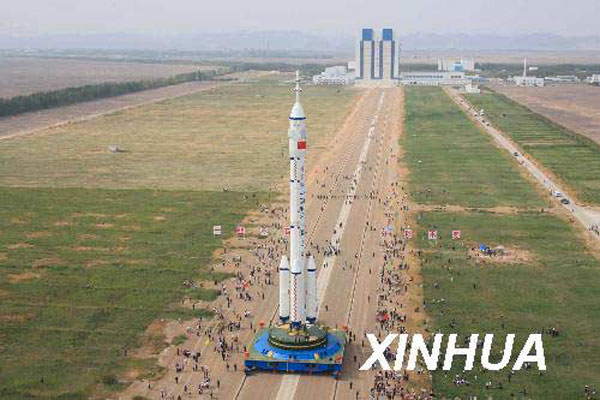

 |
| Long March 7 rocket. (Photo/Xinhua) |
"China's new generation carrier rockets, Long March 7 and Long March 5, will make their respective maiden flights in June and at the end of September to the beginning of October in 2016," said Lei Fanpei, the chairman of China Aerospace Science and Industry Corporation (CASC).
According to a CASC statement, Long March 5 is currently being tested at Wenchang Space Launch Center in south China's Hainan province. The current focus for Long March 7 is rocket production for the maiden flight.
"One of the characteristics of the new generation of carrier rockets is their use of non-toxic and non-polluting fuels," said Li Tongyu, director of the Aerospace Ministry of China's Carrier Rocket Technology Institute.
Regarded as the space transportation system that has the largest potential for development and the highest technology currently in China, Long March 5 has a payload capacity of 25 tons for low Earth orbit, and 14 tons for geostationary transfer orbit. It will increase China's space capacity more than twofold and promote the upgrade of China's active power system for carrier rockets. Long March 5 is scheduled for a three-step moon exploration program (orbit, landing and return) in 2017.
Long March 7 is the new generation of medium-size launch vehicles, and was developed to meet the demand for launching cargo spaceships toward China's manned space station. The use of tridimensional and digital platforms in design and production marks a new stage of digitalization for China's carrier rocket technology.
"The update of active carrier rockets has already been planned, though there will be a brief period of coexistence of the old and new generations. However, there is really no competition between them; they will be chosen for tasks according to relative requirements and carrying capacity," said Li Tongyu.
This article was edited and translated from《“长征五号”、“长征七号”首飞时间基本确定》. Source: www.chinanews.com. The author is Zhang Su.
 |
 PLA holds joint air-ground military drill
PLA holds joint air-ground military drill Charming female soldiers on Xisha Islands
Charming female soldiers on Xisha Islands Beautiful skiers wear shorts in snow
Beautiful skiers wear shorts in snow Getting close to the crew on China's aircraft carrier
Getting close to the crew on China's aircraft carrier A beauty's dancing youth
A beauty's dancing youth Chinese stewardess celebrate test flight at Nansha Islands
Chinese stewardess celebrate test flight at Nansha Islands World's first 'underwater skyscraper'
World's first 'underwater skyscraper'  "Rent me as your girlfriend!"
"Rent me as your girlfriend!" Top 10 weapons in the world in 2015
Top 10 weapons in the world in 2015 Top 20 hottest women in the world in 2014
Top 20 hottest women in the world in 2014 Top 10 hardest languages to learn
Top 10 hardest languages to learn 10 Chinese female stars with most beautiful faces
10 Chinese female stars with most beautiful faces China’s Top 10 Unique Bridges, Highways and Roads
China’s Top 10 Unique Bridges, Highways and Roads Visa trap
Visa trap Same-sex, same abuse
Same-sex, same abuse Chinese netizens rank Japan as least-wanted neighbor
Chinese netizens rank Japan as least-wanted neighbor ‘Detective Chinatown’ pays homage to the mystery genre
‘Detective Chinatown’ pays homage to the mystery genreDay|Week